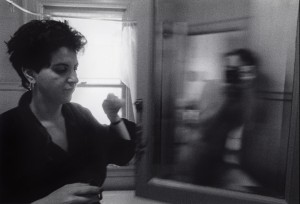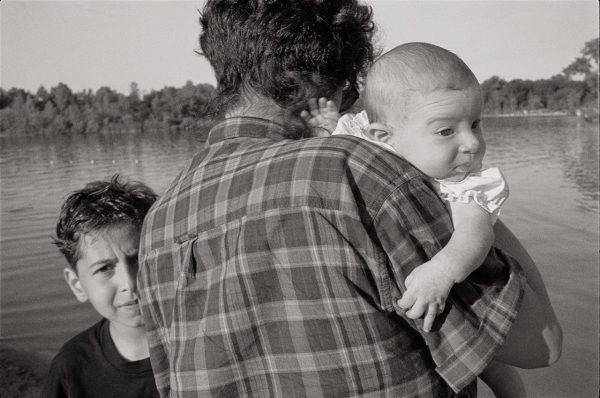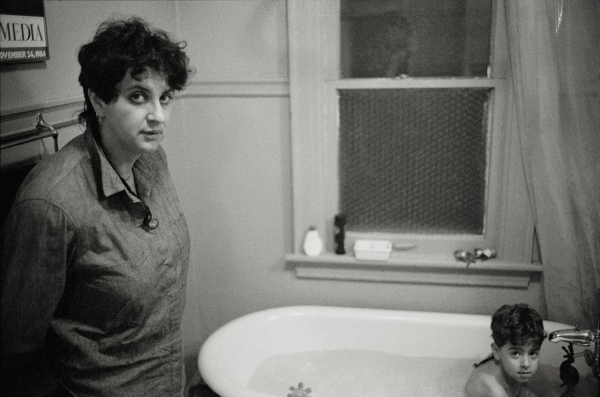Return to Issue 1 Table of Contents
Kelly Klingensmith is an Assistant Professor, Department of English at Western New England University, Springfield, MA 01119.
Living With His Camera (2003) explores Jane Gallop’s longtime cohabitation with photographer Dick Blau and his camera. (All images by Dick Blau with permission.)
 Gallop conceives of the book as an exploration of “a series of intersections” between a selection of Blau’s family photographs and resonant, influential books on photography—Roland Barthes’ Camera Lucida, Susan Sontag’s On Photography, Kathryn Harrison’s novel Exposure, and Pierre Bourdieu’s Photography (p. 12). As each of the four chapters “stages an encounter” between Blau’s images and theories of photography, Gallop produces nuanced readings of each text (p. 4). At these intersections, she theorizes from her own experience what it means to be a domestic partner, mother, and photographic subject. As Gallop says of Barthes’, hers, too, is writing that “combines intellectual work with self-reflection, theory with memoir” (p. 13).
Gallop conceives of the book as an exploration of “a series of intersections” between a selection of Blau’s family photographs and resonant, influential books on photography—Roland Barthes’ Camera Lucida, Susan Sontag’s On Photography, Kathryn Harrison’s novel Exposure, and Pierre Bourdieu’s Photography (p. 12). As each of the four chapters “stages an encounter” between Blau’s images and theories of photography, Gallop produces nuanced readings of each text (p. 4). At these intersections, she theorizes from her own experience what it means to be a domestic partner, mother, and photographic subject. As Gallop says of Barthes’, hers, too, is writing that “combines intellectual work with self-reflection, theory with memoir” (p. 13).
One of the overarching concerns of Living With His Camera is to investigate “the way the photograph both is and isn’t representative,” something readers see at most every encounter with Blau’s luminous pictures (p. 3). Whether it has to do with the interstices of space or time that the still photograph necessarily omits, Gallop’s careful attention to the visible details of the images and the contexts of photographic production repeatedly demonstrates this fundamental truth of photography.
Blau’s unconventional family photographs reveal ties to the ethnographic work he has done in projects like Skyros Carnival (2010), Bright Balkan Morning (2002), and Polka Happiness (1992) as well as his history in theater. For over forty years, Blau has also been making art photographs of the people closest to him (many to be collected in the book-in-progress, Thicker Than Water). The intimate images of family life in Living With His Camera combine some of the haunting revelations of Sally Mann’s with the affectionate irony of Larry Sultan’s.
In order to explore Blau’s images deeply, Gallop accesses multiple perspectives. Reading first as spectator and feminist psychoanalytic critic, she finds in one image a mother and son’s hostility toward the father/photographer who has intruded on the intimacy of the boy’s evening bath. In their striking genetic and compositional similarity, she sees no less than the father’s “genetic irrelevance” (p. 41). Speaking here from the position of spectator, Gallop reads the image as one that “[exposes] the patriarchal underpinnings of polite family photography” (p. 42). But the image is more and other than this. Taking up the alternate position of photographed subject allows Gallop to recall the typical patterns of home life that include a more equitable division of domestic labor and far less hostility than the photograph alone suggests.
In something the typical academic book on photography can not offer, Blau voices his own memory of the production of the image, which serves not to pin down its ultimate meaning, but to demonstrate the way photographs are always more and less than what we see. He recalls directing his unwitting actors into the desired expression by opening the door and “commanding” they look at him, knowing in advance the reaction he would receive (p. 43). “By sounding like a patriarch,” Gallop writes, “he produced a tableau of resentment from the subjects of patriarchal authority. The response was so fleeting, I never even knew I’d participated in a drama” (p. 43).
Here, as elsewhere in the book, photography is re-conceived as a collaborative process that requires, at least to some degree, the participation of its subjects. At another instance Gallop recalls holding an expression in the midst of an argument, helping to make the photographic record of her anger. In the book she also shares the negotiations that accompany decisions to make public the very private, an ethical imperative when photography is a family affair.
Working between subjective experience and close readings of text and image, Gallop offers a convincingly dialogic mode of criticism that augments the existing body of theoretical work on photography. Readers will find, for instance, an immanently useful reading and revision of Sontag’s influential theory in On Photography. Noting first that the ideologically suspect structures particular to tourist photography inform Sontag’s understanding of photography on the whole, Gallop reveals how Sontag’s understanding is structured by a “logic that mistakes the [photograph’s] moment for eternity” (p. 73). Such logic allows Sontag to pronounce photography in general an “act of non-intervention,” an enterprise born of the photographer’s dubious interest and aesthetic profit in the “pain or misfortune” of others (Sontag, quoted in Gallop, p. 71). It is, in part, Gallop’s familial relationship with photography that allows her to see what Sontag, as solely a spectator of it, cannot—and that is the life in-between photographed moments.

The revision extends beyond what Gallop’s privileged access affords, however. Reading Blau’s photographs, Gallop postulates a “parental gaze” that structures his domestic photography, seeing in photographs of her children’s and her own emotional pain both Blau’s sympathetic recognition of the intensity of that suffering and also the distanced view that reveals, through often ironic framing and composition, its disproportions and comedic registers. It is a “strange combination of caring and detachment” that Gallop finds operating in Blau’s photography. Moving outward, she theorizes that same combination to be the broad structure intrinsic to parenting and her own critical method as well (p. 85). A “partial detachment” that “maintains connection to … subjective experience” but moves beyond the mere reinforcing of what one already suspects, to produce instead new and greater knowledge (p. 86).
The playfulness of the book and the seemingly loose structure that travels so lightly between texts and keen observations belie a rigorous method and sharp intellect. As meaning resonates between these texts, Gallop listens very carefully.
Living With His Camera, text by Jane Gallop, photographs by Dick Blau.
Duke University Press, 2003. 27 b&w photographs.
Return to Issue 1 Table of Contents
(You are invited to add to the conversation below.)

